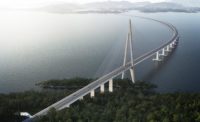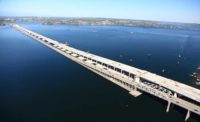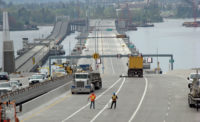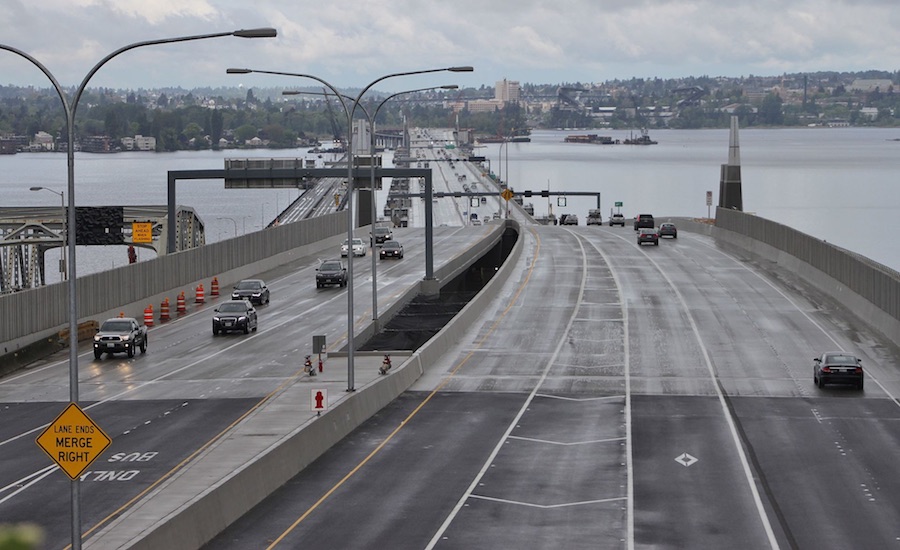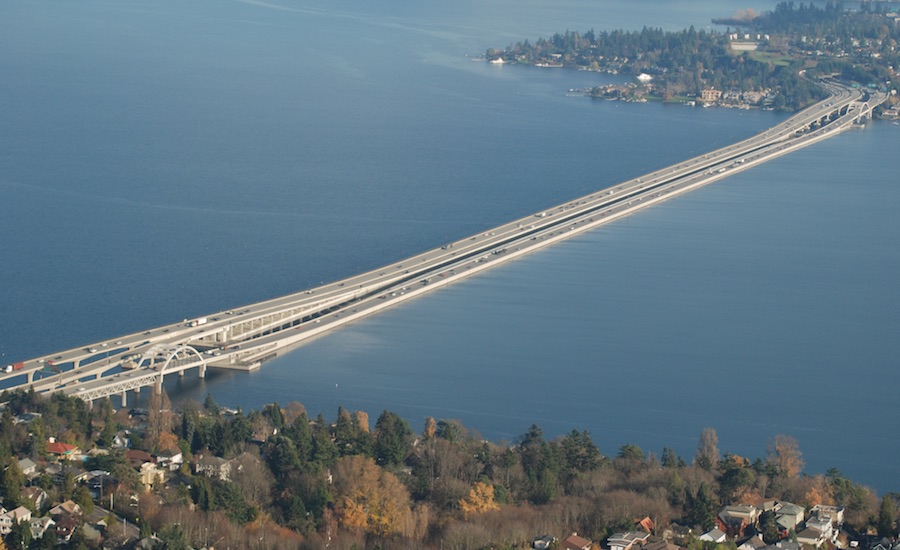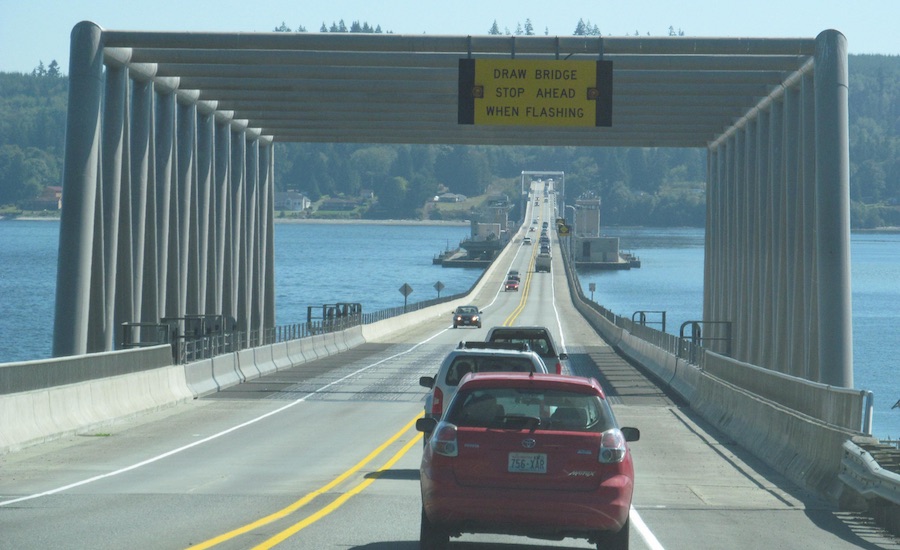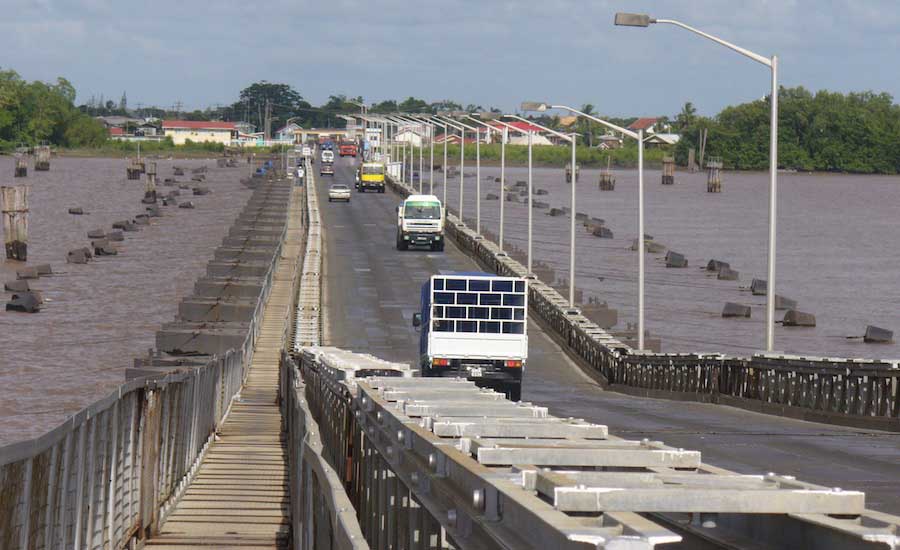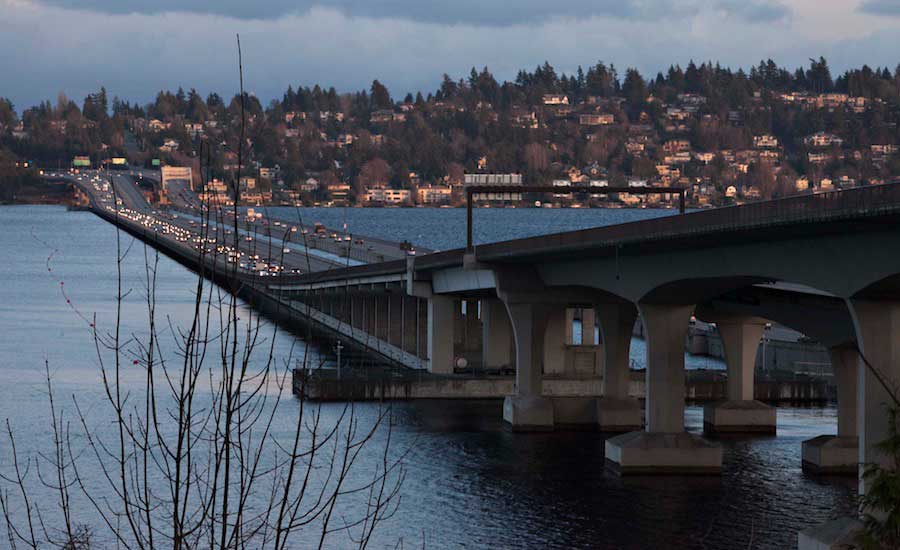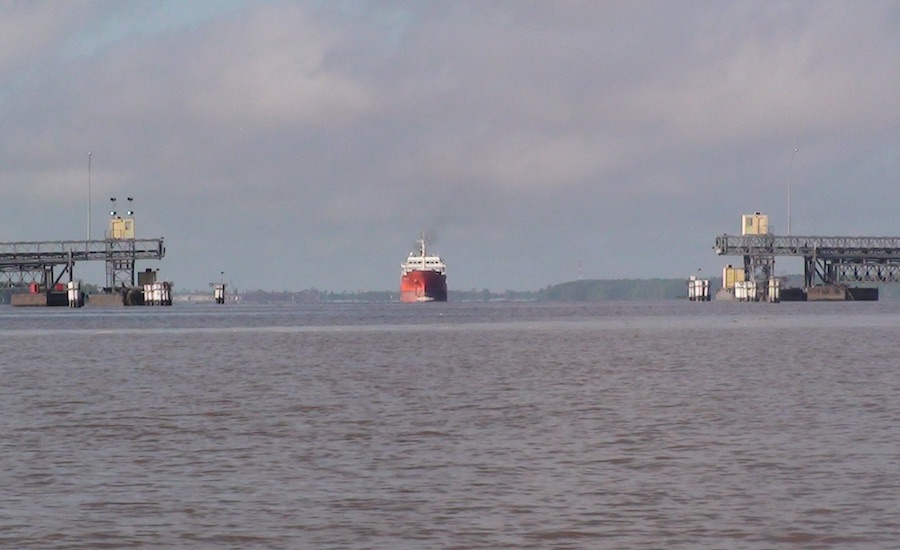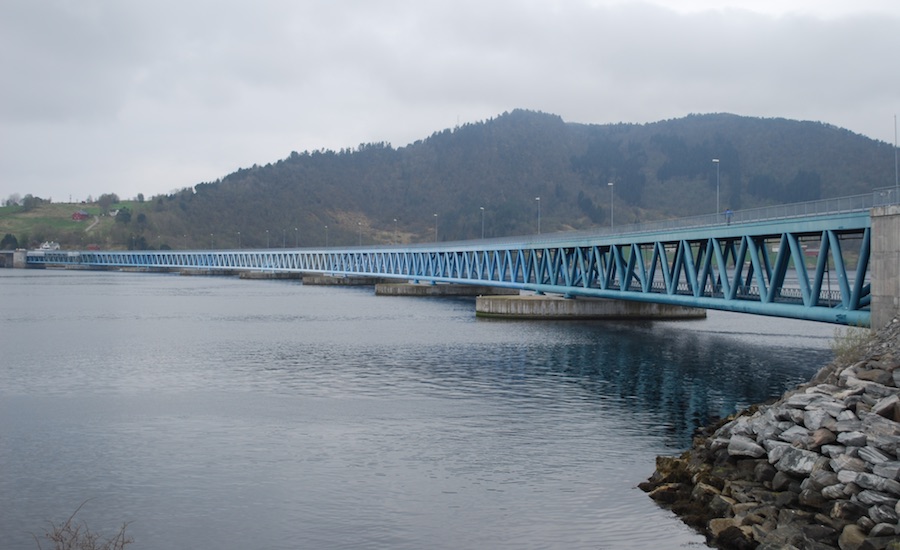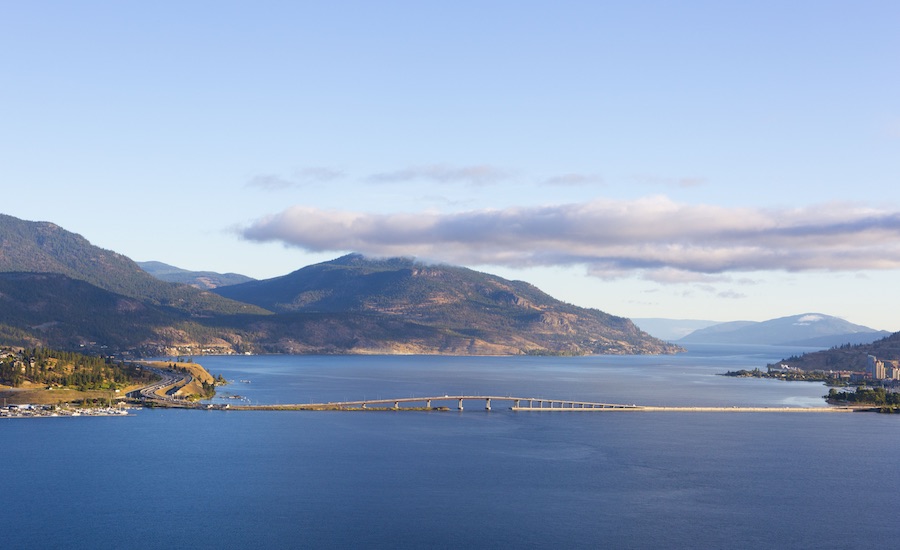Global Infrastructure
The 10 Longest Floating Bridges in the World
A survey of pontoon bridges that push the limits of the technology

1. Evergreen Point Floating Bridge, Seattle, U.S.A., 2,350 meters (floating portion of bridge), completed 2016. The six-lane bridge carries State Route 520 across Lake Washington from Seattle to its eastern suburbs. It features 77 concrete pontoons secured to the lake bottom by 58 anchors tethered to steel cables. Twenty-one of the pontoons that support the deck and superstructure are each 110 m x 23 m x 8.5 m and weigh 10,000 tonnes. Fifty-four supplemental pontoons used to stabilize the weight of the bridge weigh 2,300 tonnes each. Two cross pontoons weighing 9,200 tonnes each at each end connect the deck to the fixed bridge approaches using hinges. The pontoons were designed by WSDOT and the superstructure by KPFF. The bridge was built by a joint venture made up of Kiewit Corp., General Construction Co. and Manson Construction. The lake's topography—a water depth of 61 m atop 61 m of soft silt —favored the choice of a floating bridge, as a conventional bridge would be prohibitively expensive and require costly towers and huge approaches that would be out of character with the largely residential area. The construction cost was $4.5 billion. It replaced the previous Evergreen Point Floating Bridge, a four-lane span that opened in 1963.
Photo by Wikimedia Commons

2. Lacey V. Murrow Memorial Bridge, Seattle, U.S.A., 2,020 meters, 1940. The bridge carries the eastbound lanes of Interstate 90 across Lake Washington from Seattle to Mercer Island, Wash. The world's first floating bridge to be built using concrete pontoons, it was designed by engineer Homer Hadley, and constructed by the Puget Sound Bridge and Dredging Co., at a price tag of $9 million. While undergoing reconstruction in 1990, an 850-m-long section of the bridge sank when a storm filled one pontoon. The rebuilt bridge reopened in 1993, at a cost of $93 million.
Photo Courtesy of WSDOT

3. Hood Canal Bridge, U.S.A., 1,988 meters, 1961. The bridge carries State Route 104 across Hood Canal, a natural fjord that empties into Puget Sound. The bridge connects the Olympic and Kitsap Peninsulas. The water depth at the site ranges from 24 to 104 m, with several hundred feet of mud below, which made construction of support columns for conventional bridges too costly. A windstorm in 1979 caused some of the pontoons to break loose from their moorings and sink. The bridge was rebuilt and resumed operation in 1982. Between 2003 and 2009, the Washington State Dept. of Transportation replaced the eastern half of the bridge's floating section, the east and west approach spans, the east and west transition spans, and the west-half electrical system. Fourteen pontoons were fabricated at Concrete Technology in Tacoma. Each pontoon has about 40 individual cells.
Photo by Wikimedia Commons

4. Demerara Harbour Bridge, Guyana, 1,851 meters, 1978. The bridge spans the mouth of the Demerara River at Guyana's capital, Georgetown. Thos. Storey (Engineers) Ltd., a British firm known for manufacturing Bailey Bridges, designed and also fabricated the bridge components. Guyana's Ministry of Works and Transport designed the abutments, toll plaza and western approach road. The two-lane bridge currently carries an average of 14,000 vehicles per day. The bridge's capacity is limited by having to open daily to allow river traffic to pass, and the retraction process is slow. Also, bridge opening times depend on water levels and flow velocities (tide), which often conflict with peak traffic times. The Demerara Harbour Bridge Corp., the bridge's owner-operator, hired LievenseCSO, a Dutch hydraulic and coastal engineering firm, to conduct a feasibility study and design for a new Demerara River Crossing. Their report, issued in August, 2017, states that the existing bridge "has long passed its technical lifetime" and "is no longer able to service the present and future traffic demand." It recommended the construction of a new three-lane bridge with fixed footings.
Photo by Wikimedia Commons

5. Homer M. Hadley Memorial Bridge, U.S.A., 1,772 meters, 1989. It carries the westbound and reversible lanes of Interstate 90 across Lake Washington between Mercer Island, Wash., and Seattle. The construction cost was $97 million. It is named for Homer Hadley, the engineer who designed the bridge's companion span, the Lacey V. Murrow Memorial Bridge. It features 18 pontoons: 10 concrete and nine with elevated superstructure.
Photo Courtesy of WSDOT

6. Berbice Bridge, Guyana, 1,571 meters, 2008. The bridge spans the mouth of the Berbice River and features 39 pontoons. It was built by the consortium of Bosch Rexroth and Mabey & Johnson. The construction cost was $38 million. It opens for river traffic for 1½ hours each day. Cars pay a toll of 2,200 Guyanese dollars (U.S. $10).
Photo Courtesy of Berbice Bridge Co.

7. Nordhordland Bridge, Norway, 1,246 meters (pontoon section), 1994. This combined cable-stayed and pontoon bridge near the city of Bergen connects the mainland and the island of Flatøy, spanning Salhusfjorden, which is 500 m deep. It carries two lanes for cars and a pedestrian/bicycle path. The floating section is a steel box girder on top of 10 concrete pontoons, each with nine watertight cells. It was designed by Aas-Jakobsen. Given the fjord's extreme depth, lateral anchorage systems would have been too expensive. Instead, the pontoons are fastened with flexible plate connections liked by bolts and cables under tension. It was built by a consortium, Arbeidsfellesskapet Salhus Bru, made up of Norwegian Contractors, Aker Entreprenør, Veidekke and Kvaerner Eureka.
Photo Courtesy of Norwegian Public Roads Administration

8. Bergsøysund Bridge, Norway, 933 meters, 1992. The bridge connects the islands of Aspøya and Bergsøya, spanning a fjord with a water depth of 320 meters. The engineering firm Johns. Holt designed the pontoons and abutments, and DNV Veritec designed the steel superstructure. Norwegian Contractors built the concrete pontoons, and Aker Verdal built the steel pipe truss superstructure. It rests on seven concrete pontoon foundations.
Photo Courtesy of Norwegian Public Roads Administration

9. William R. Bennett Bridge, British Columbia, Canada, 690 meters, 2008. SNC-Lavalin handled the design and construction and received a contract to operate and maintain the bridge for 30 years, as a public-private partnership. Buckland & Taylor Ltd. were the lead design firm, in partnership with SNC-Lavalin. The five-lane bridge rests on nine pontoons, all of them 25 m wide, and ranging in length from 25 m to 90 m. The construction cost was 144.5 million Canadian dollars. It replaced the three-lane Okanagan Lake Bridge, another floating bridge, which had been erected in 1958. According to SNC-Lavalin, the project's many challenges included "an aggressive schedule, building the bridge alongside existing floating bridge and accommodating normal traffic during construction, the labor supply due to a booming market, an archaeology zone and First Nation consultations and the existing bridge demolition."
Photo Courtesy of SNC-Lavalin

10. Yumemai Bridge, Osaka, Japan, 410 meters. The world's first floating swing bridge, it connects two artificial islands, Yumeshima and Maishima, in Osaka Bay. A floating bridge design was chosen because the soft ground of the reclaimed land was more suited to this approach. The bridge's double arches rest on two large steel pontoons. The pontoons were designed to resist corrosion by lining their sides with titanium plates as well as a cathodic protection system. The floating portion of the bridge weighs 30,000 tons. The North Waterway which it crosses is rarely used by boats, but when it is, the bridge is maneuvered by tugboats.
Photo by Wikimedia Commons










Permanent floating bridges are essentially boutique structures that only make sense for certain rare kinds of sites: unusually deep bodies of water and bodies of water with very soft bottoms, where piers are impractical.
Norway, which already boasts two of the world's longest floating bridges, is the one country most actively studying new pontoon bridge projects. Its E39 coastal highway, a long-range megaproject, will incorporate eight major water crossings. One of those crossings, Bjørnafjorden, is likely to be a pontoon bridge.
"We have recommended a floating bridge, but we have not decided whether it will be an end-anchored floating bridge (like Bergsøysund and Nordhordland) or if it will be a side-anchored floating bridge with moorings to the seabed [in the fashion of the floating bridges around Seattle]," says Eidem Mathias Egeland, project manager, fjord crossing project, Norwegian Public Roads Administration. "The big challenge for a side-anchored floating bridge here, compared to the ones around Seattle, is the depth. The deepest mooring on the Hood Canal Bridge is 120 meters below sea level, while the depth of the Bjørnafjord is over 600 m at its deepest."
NPRA has commissioned studies of both options. "Multiconsult, together with Johs Holt, NGI, Entail, Rambøll and Aker Solutions, conducted the study for the side-anchored floating bridge," says Egeland, "while Norconsult, Dr.techn.Olav Olsen, NGI, Aker Solutions and Aas-Jakobsen conducted the study for the end-anchored floating bridge. The next step will be further study of the two floating bridge concepts so that we can make a final decision between the two."
The four longest pontoon bridges in the U.S. are all located in the Seattle area. The oldest one, the Lacey Murrow Memorial Bridge, was based on a concept by visionary engineer Homer Hadley, who had developed his idea after building concrete barges during World War I. He first proposed his idea at a meeting of the American Society of Civil Engineers in 1921, but was rejected. Hadley went on to work for the Portland Cement Association. Eventually, he convinced the Washington State Dept. of Highways to try his idea. Completed in 1940, it was the first floating bridge to incorporate concrete pontoons.
The topographical features of two water bodies in the Seattle region favor floating bridges. "The depth of the water and length of the open water spans are WSDOT's main reason for building floating bridges," explains Steve Peer, media and construction communications manager, Washington State Dept. of Transportation. "Lake Washington is a deep lake with 200 ft of water on top of 150-200 ft of soft diatomaceous soil. Hood Canal has water depths in some places more than 300 ft. To cross Lake Washington and Hood Canal, bridges also need to span more than a mile. Support piers for a traditional bridge would need to be taller than a 40-story building and a suspension bridge like the Golden Gate bridge would need to be massive in scale to lift [suspend] the bridge out of the water. The bottom line: A floating bridge is the most practical bridge structurally and financially for our region's unique conditions."
The region's newest floating bridge, the Evergreen Point Bridge, is the world's longest floating bridge and opened in 2016. It replaced an earlier floating bridge and provided more traffic capacity. It was designed with the ability to add light rail to the bridge in the future. To overcome weather and maintenance issues, the design team raised the bridge deck 20 ft off the pontoons, thereby allowing complete access to all bridge systems from below. "What made the design a challenge is that a floating bridge tends to flex and twist due to live and environmental loads and thus the superstructure needed to have sufficient articulation so that it could allow for these anticipated movements," says Michael Abrahams, technical director, structures, WSP USA.
WSDOT expects to claim another milestone when it adds light rail service to the existing Homer Hadley Bridge on Lake Washington. The challenge for Sound Transit was how to install rails on a bridge that uses accordion joints to transition from a fixed structure to a floating structure that, due to water levels, rises and falls as much as 2 ft. Beginning with a consulting team led by what is now WSP, Andy Foan, director of the U.K.-based Andy Foan Ltd., devised the "curved element supported rail," a winged, curved platform at the two joints where the bridge transitions between fixed and floating.
"The WSP design team developed, analyzed and prototype-tested [at full scale] the curved-element design that met Sound Transit's light rail service performance objectives," says Abrahams. "It can be thought of as a continuously variable radius track panel that could be used in other applications, such as floating dockyards or track in glacial or seismic areas." Construction is expected to commence this summer and be completed by 2020.
Abrahams also helped design the only other sizable floating bridge in the U.S. outside Washington state, the Ford Island Bridge (aka the Admiral Clarey Bridge) in Hawaii. The Navy "required a bridge across Pearl Harbor to provide a low-level crossing that would minimize the visual impact on the nearby U.S.S. Arizona war memorial as well as provide a 650-ft navigation channel that could be traversed by an aircraft carrier," explains Abrahams. The 4,672-ft long bridge features a 930-ft-long pontoon section; it was completed in 1998.
Floating bridges are being looked at in several other countries that already have such structures. Officials from Nagasaki, Japan, are considering building a floating bridge on Omura Bay to offer additional access to an airport. And a second floating bridge across Lake Okanagan in Canada is a possible option.
One distinctive aspect of pontoon bridges is their maintenance needs. "They require more maintenance due to the floating nature of the bridge," says Nicolas Ryan, media relations adviser, SNC-Lavalin. "The joints will experience a larger degree of movements since the bridge is floating. The movements will cause more wear and tear of the joints during normal operation."
While permanent floating bridges have an established reputation, there are few of them, whereas temporary floating bridges are much more common, both for military maneuvers and civil emergencies. They were widely used by both Allied and Axis forces in World War II, most notably by American units to cross the Rhine River after retreating German forces had destroyed existing bridges.


